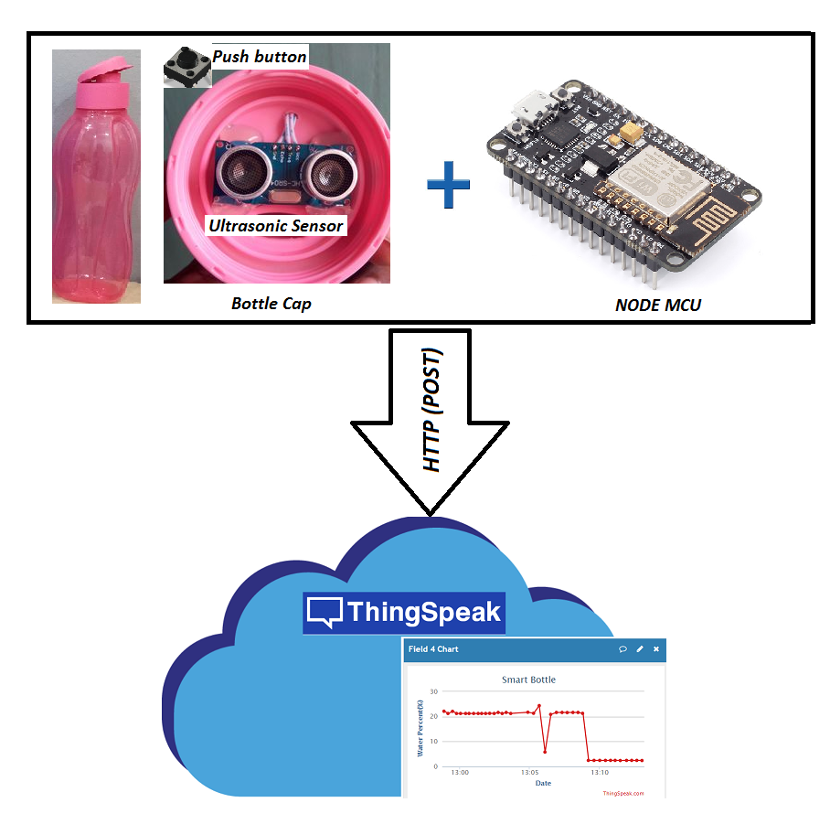Smart bottle IOT concept
- 5 minutes read - 876 wordsThe rapid growth of Internet of Things (IoT) and miniature wearable biosensors have generated new opportunities for personalized eHealth and mHealth services. We present a case study of an intelligent cap that can measure the amount of water in the bottle, monitor activity of opening or closing of bottle cap. This paper presents a Proof of Concept implementation for such a connected smart bottle that sends measurements to the IoT Platform.
Exponential growth of the number of physical objects connected to the Internet, also known as Internet of Things or IoT, is expected to reach 50 billion devices by 2020 [1]. New applications include smart homes, transportation, healthcare, and industrial automation. Smart objects in our environment can provide context awareness that is often missing during monitoring of activities of daily living [2], [3].
One of the most important factors for health and wellbeing is proper hydration. In our busy lives, it is hard to remember to drink enough water. And most of the time we forget to drink enough water whether we are in the home, office or on-the-go. Around 75% of Americans are chronically dehydrated all the time.
Water makes up 60% of our body, 75% of our brain, and 83% of our blood. An intelligent hydration monitoring and management platform can provide automatic, accurate, and reliable monitoring of fluid consumption and provide configurable advice for optimum personalized hydration management. A smart water bottle can satisfy the needs of a variety of groups, including athletes that want to enhance performance, dieters that want to achieve their weight goals, as well as elderly in group homes or living alone that often suffer from dehydration. While most users who seek to improve, their wellness have insufficient water intake, some medical applications require limiting of water intake. Typical examples include kidney disease and congestive heart failure (CHF) patients that need to comply with recommended water intake protocols and limit the total amount of water taken during the day while still taking water regularly throughout the day. An integrated hydration management platform enables users to receive alerts and reminders of when to drink, set goals for how much to drink, show current and previous consumption levels etc. The first intelligent water bottle on the market was Hydra Coach. The bottle features a display that presents hydration information, but no wireless connectivity [4]. The new generation of bottles, such as HydrateMe and Trago feature Bluetooth wireless interfaces and custom smartphone and smartwatch applications [5].
A smart water bottle measures the amount of water a person is drinking through sensor technology, usually located in the cap of the bottle. The features of a smart water bottle can also include, temperature sensors, freshness timers, drinking reminders, and daily hydration statistics. These additional features can help the drinker know when to fill up their bottle, how often they are drinking and how much more water they should include into their daily goal.
Solution Concept
A smart bottle integrated through an ultrasonic sensor, a push button, a NodeMCU and a LIPO battery as presented in Fig. 1. The controller (NodeMCU) communicates with the cloud using ESP8266 12-E wireless interface. The controller processes data from the smart bottle and sends processed information to the cloud thingspeak.

Programming in NodeMCU is same as Arduino. Now let’s discuss the implementation of the system in steps:
- Ultrasonic Sensor and pushbutton is integrated with the NodeMCU digital I/O pins.
- Ultrasonic Sensor sends the distance of the water level from the cap of the bottle.
- Based on the distance of the water, controller calculate the percentage of water and sends to the thingspeak cloud using http POST request.
- Similarly, push button also detects the pressed event and sends the event in the thingspeak.
Working Demo here
Constraints and Challenges
Currently the Smart Bottle system have following limitations that can be worked upon in coming future:
- The ultrasonic sensor is not safe from water so, bottle can’t be tilted in closed condition.
Conclusion
The Smart Bottle System displays lot of potential and can be extended to implement advance features and functionalities. The advance feature list includes but not limited to the following:
- Water proof ultrasonic sensor to overcome our constraints.
- The same can be implemented using HX711-Weight sensor with load cell.
- Instead of using the push button we can use the hall sensor to detect the opening of bottle cap.
References
- [1] A. Al-Fuqaha, M. Guizani, M. Mohammadi, M. Aledhari, and M. Ayyash, “Internet of Things: A Survey on Enabling Technologies, Protocols, and Applications,” IEEE Commun. Surv. Tutor., vol. 17, no. 4, pp. 2347–2376, Fourthquarter 2015.
- [2] C. Perera, A. Zaslavsky, P. Christen, and D. Georgakopoulos, “Context Aware Computing for The Internet of Things: A Survey,” IEEE Commun. Surv. Tutor., vol. 16, no. 1, pp. 414–454, First 2014.
- [3] L. Hood, J. C. Lovejoy, and N. D. Price, “Integrating big data and actionable health coaching to optimize wellness,” BMC Med., vol. 13, p. 4, 2015
- [4] Emil Jovanov, Vindhya R Nallathimmareddygari, Jonathan E. Pryor,”SmartStuff: A Case Study of a Smart Water Bottle”, 978-1-4577-0220-4/16, 2016
- [5] “The future of fitness: Custom Gatorade, smart water bottles, and a patch that analyzes your sweat | Macworld.”
- http://www.macworld.com/article/3044555/hardware/the-future-of-fitness-custom-gatorade-smart-waterbottles-and-a-patch-that-analyzes-your-sweat.html
I worked on this concept with my colleague Ricktam K at IoT Center of Excellence of Nagarro
#smart bottle #IOT #smart cap #concept #enterprise #Node MCU #Ultrasonic #thingspeak #nagarro #technology